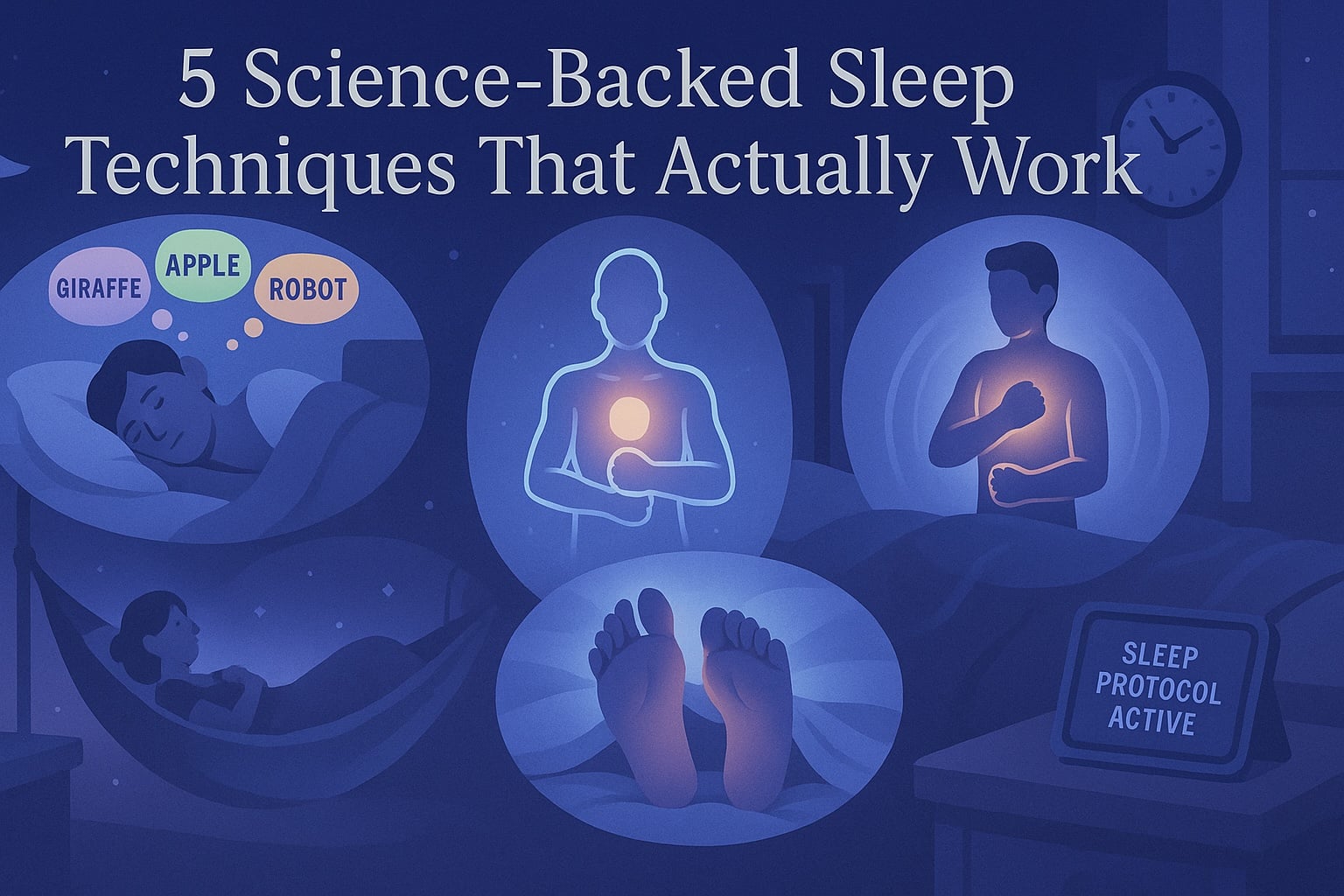5 Science-Backed Sleep Techniques That Actually Work
As someone who’s always looking for ways to optimize performance and well-being, I’ve recently come across some fascinating sleep techniques that deserve sharing. These aren’t your typical “count sheep” remedies – they’re backed by science and have helped countless people overcome those frustrating nights of tossing and turning.
1. Cognitive Shuffling: The Mental Trick That Outsmarts Insomnia
Imagine if you could trick your brain into falling asleep by thinking of random words. That’s essentially what cognitive shuffling does, and it’s surprisingly effective.
Developed by Dr. Luc Beaudoin, a cognitive scientist at Simon Fraser University, this technique works by mimicking the natural thought patterns that occur as we drift off to sleep. When our minds race with worries or to-do lists, cognitive shuffling gives our brain something neutral to focus on instead.
How to Practice Cognitive Shuffling
- Choose a seed word with at least 5 letters (like “GARDEN”)
- For each letter, think of words that start with that letter
- Visualize each word briefly before moving to the next
- Keep it random – don’t try to create logical connections
For example, with “GARDEN”:
- G: giraffe, grape, guitar, glove
- A: apple, astronaut, anchor, album
- R: rainbow, robot, river, racket
The beauty of this technique lies in its simplicity. Research shows that people typically fall asleep within 5-15 minutes when using cognitive shuffling effectively.
2. Progressive Muscle Relaxation: Your Body’s Natural Sleep Switch
Progressive Muscle Relaxation (PMR) has been around since the 1930s, but it remains one of the most effective techniques for inducing sleep. The premise is simple: physical relaxation naturally leads to mental relaxation.
The PMR Process
- Start at your feet and work your way up
- Tense each muscle group for 5-10 seconds
- Release suddenly and notice the relaxation
- Rest for 10-20 seconds before moving to the next group
What makes PMR particularly powerful is that it activates your parasympathetic nervous system – your body’s “rest and digest” mode. Studies have shown it not only helps you fall asleep faster but also increases the quality of deep sleep.
Quick PMR Sequence
- Feet and toes
- Calves
- Thighs
- Buttocks
- Abdomen
- Chest
- Arms and hands
- Shoulders
- Neck
- Face
Many people report falling asleep before they even complete the full sequence!

3. The Power of Gentle Rocking
Here’s something fascinating: adults benefit from rocking just as much as babies do. Recent studies from the University of Geneva showed that gentle rocking movements can:
- Reduce sleep onset time by nearly 40%
- Increase deep sleep duration
- Boost memory consolidation
- Synchronize brain waves for better sleep quality
DIY Rocking Techniques
If you don’t have access to a rocking bed, try these alternatives:
- Side-to-side self-rocking: Lie on your side and gently rock your body back and forth
- Hammock simulation: Use a reclining chair that allows gentle movement
- Visualization: Imagine yourself in a gently rocking boat or hammock
The key is a slow, rhythmic motion – about one complete rock every 4 seconds works best.
4. Foot Movement Meditation
This technique, sometimes called “cricketing,” involves gentle foot movements under the covers. It’s surprisingly effective and works on multiple levels:
- Creates a soothing sensory experience
- Provides a focal point for your attention
- Activates pressure points that promote relaxation
How to Practice
- Get comfortable in bed
- Gently move your feet against the sheets
- Pay attention to the texture and temperature
- Focus on the rhythmic movement
- Let your breathing naturally slow down
5. Strategic Muscle Tensing for Deep Relaxation
This advanced technique takes muscle relaxation to the next level:
- Choose a muscle group and tense it as hard as possible
- Hold the tension for as long as you can manage
- Release completely and feel the wave of relaxation
- Move systematically through your entire body
The key difference from standard PMR? You’re pushing each muscle group to its limit, creating a more profound relaxation response.
Combining Techniques for Maximum Effect
The real magic happens when you combine these techniques. Here’s my recommended sleep protocol:
- Start with 5 minutes of PMR to release physical tension
- Add gentle foot movements for sensory grounding
- Finish with cognitive shuffling to quiet mental chatter
Important Considerations
While these techniques are generally safe and effective, remember:
- Consistency is key – practice regularly for best results
- Don’t force it – if a technique isn’t working after 20 minutes, take a break
- Consider your environment – ensure your room is dark, quiet, and cool
- Seek professional help if sleep problems persist beyond 3 weeks
The Science Behind Why These Work
All these techniques share common mechanisms:
- Cognitive distraction from anxiety-inducing thoughts
- Activation of the parasympathetic nervous system
- Mimicry of natural sleep-onset processes
- Reduction in cortisol and stress hormones
Conclusion
Good sleep isn’t just about quantity – it’s about quality. These science-backed techniques offer practical, drug-free solutions for those nights when sleep seems elusive. As someone who values both productivity and well-being, I’ve found these methods invaluable for ensuring I wake up refreshed and ready to tackle whatever challenges lie ahead.
Remember, the best sleep technique is the one that works for you. Experiment with these methods, combine them as needed, and give yourself time to master them. Your future well-rested self will thank you.
Sweet dreams!